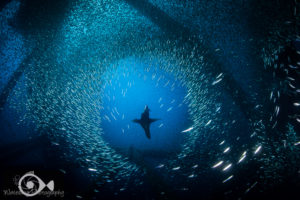One of the challenging things as an underwater photographer is getting your subjects to face the camera. Marine critters are inexplicably camera shy! Most likely, it is because of the bright focus light you are shining in their face, but it could also be that your dome port looks like a big eye and that can freak out any little beasty. Luckily for photographers, there are some tricks we can try, and common sense we can apply.
Trick #1: Red Light!
Underwater camera gear manufacturers are aware of the lighting issues photographers face. On one hand, we must have enough light that our camera can focus on the subject and the thing we want in focus the most is our subject’s eye. On the other hand, shining a bright light in our subjects eyes causes it to turn away before we can get the shot. The solution to this is a red focus light. Several lights on the market have a switch that will turn the light red, a color that is theoretically not seen by marine animals. The following image is a good example of critters that don’t tolerate light well. The pygmy sea horse has no eyelids and cannot shut it’s eyes. Because it is so small, it is a challenge to focus on, even with good light, and the moment you get it in focus, it turns away.

However, with a red focus light, there is enough light for the camera to focus, but the animal is not as sensitive to it and it is more likely to face the lens, such as in the image below. (Don’t worry about the red showing up in the image. When your strobes fire, all the red will disappear.)

Pygmy Seahorse
Trick #2: Fake them out!
Another trick to help turn a camera shy critter toward the lens is to hand hold the focus light behind the animal, or have your dive buddy hold the light so that it faces the camera. The animal will turn away from the light, toward the camera. There will be enough light for the camera to focus, and walla!

Flamboyant Cuttlefish
Okay, on to using some common sense:
#3 Patience is a virtue
Sometimes you just have to wait for the critter to get used to you. Most marine animals have little or no brains. Instead, they have fight or flight instincts. If you are not perceived as a threat, it only takes a few minutes for the critter to forget about you. As far as it knows, you may have been a feature in it’s environment for months or years. Give your subject time to forget about you, and eventually it may face the camera without being coaxed. This goby and shrimp took only a few moments to forget I was there, and go about their business of shoveling sand out of their home.

This leads me to a cardinal rule,
#4: Don’t be a Predator!
Nothing is more displeasing to an underwater photographer than getting pictures of fish butts. Sometimes we become so excited to get a shot of that rare critter, just to prove we saw it, that we sacrifice good photography. The following image is of a goby on eggs. I really wanted this image, but unfortunately, in my excitement, I was not patient, I did not use red light, and I stalked this poor fish. The result is a fish facing away from the camera, eye blurred, and generally just an uninteresting photograph.

Chasing the animals produces the same result. This poor harlequin shrimp felt very vulnerable and could only flee from my big bubble blowing self.

So remember, try red light, move your focus light behind the subject, wait for your subject to forget about you, and don’t be a predator. Using these tips will help you get good “face on” shots.

Jawfish with eggs



